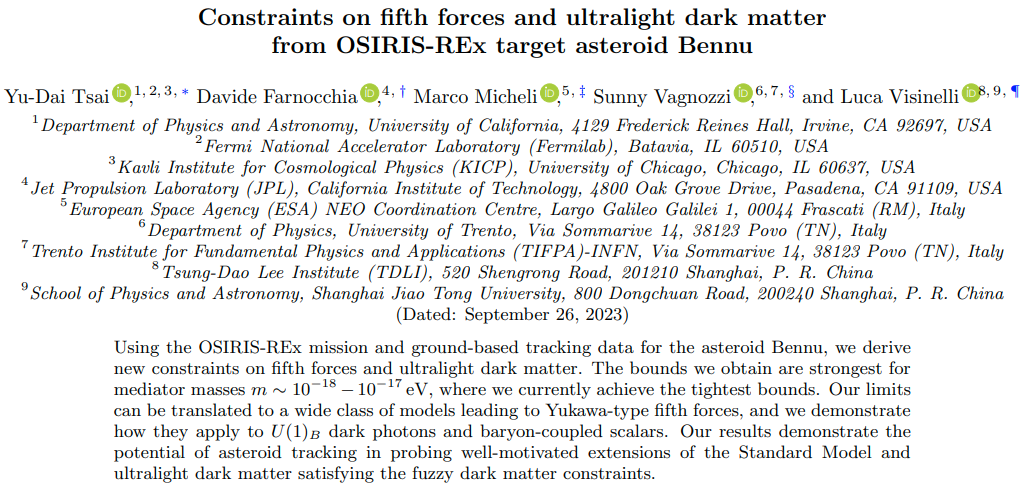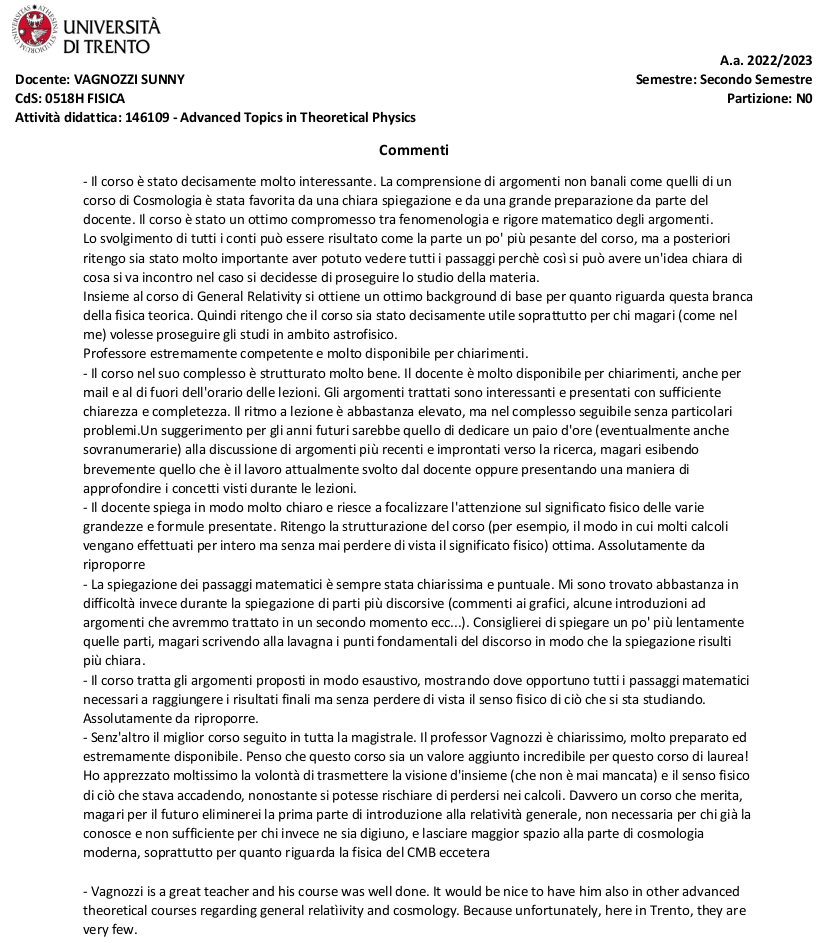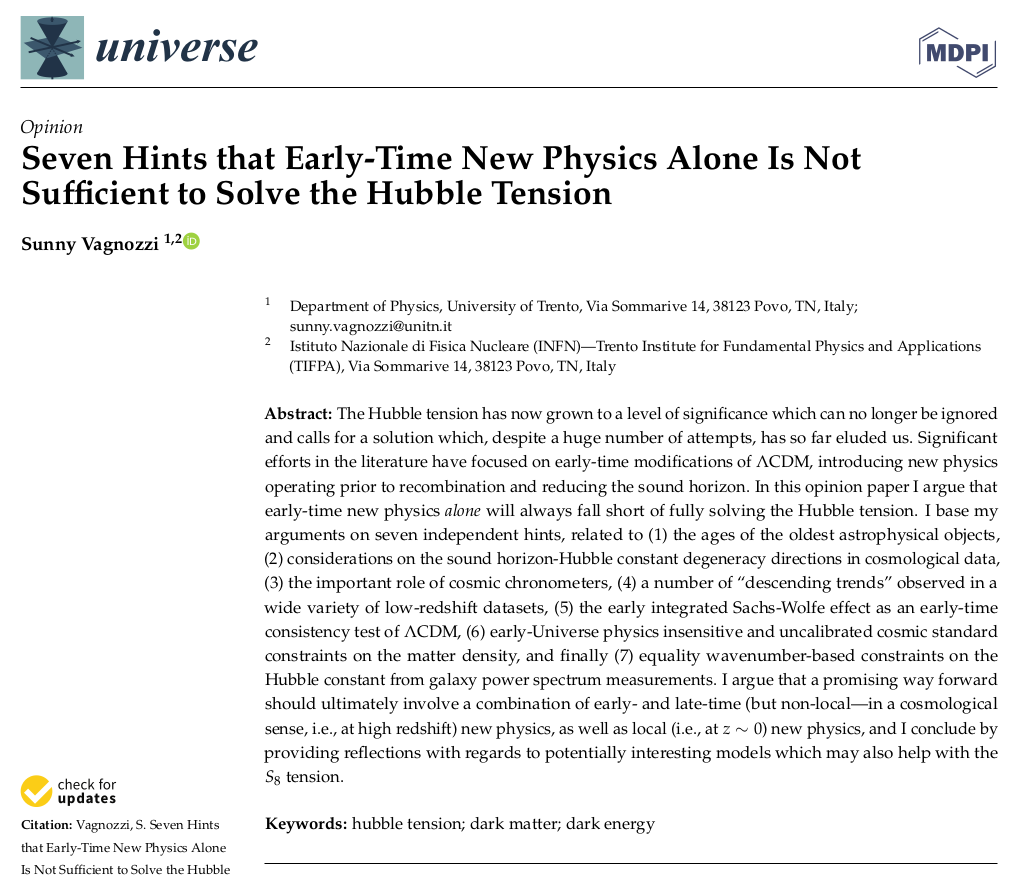My paper with Shahnawaz Adil, Upala Mukhopadhyay, and Anjan Sen, where we show how a dark energy model featuring a negative cosmological constant with an evolving component on top can potentially explain the puzzling JWST observations (see this earlier news item), has been accepted for publication in JCAP! The revision requested was pretty minor, but a notable (and in my opinion rather important) addition is the new Fig. 1 I produced, where we show the effective equation of state of this dark energy model. In some cases it goes through a singularity, which indicates the point where the total energy density of the dark energy switches sign. The singularity is nothing to worry about, as we argued. You can read the preprint version of the paper on arXiv: 2307.12763.
Constraints on fifth forces from OSIRIS-REx tracking data for Bennu
Really excited about the new preprint we just posted with Yu-Dai Tsai, Davide Farnocchia, Marco Micheli, and Luca Visinelli, where we use OSIRIS-REx tracking data for the asteroid Bennu to set new constraints on fifth forces and ultralight dark matter - in certain ranges of mediator mass these are among the tightest constraints ever obtained! This is a follow-up to our earlier paper in JCAP where we only considered the effect of such particles on the asteroid orbital precession. In our new preprint we are instead using real tracking data from the OSIRIS-REx mission and ground-based optical and radar telescopes, gathering as much information as possible on Bennu’s full trajectory. The timing is, to say the least, perfect, as in the past days OSIRIS-REx has been making headlines, being on its way back to Earth with a sample of Bennu. You can read our results in the preprint we just posted on arXiv: 2309.13106.
Seven hints paper makes cover page of September issue!
My seven hints paper - Universe 9 (2023) 393 - has been selected as cover story for the September 2023 issue (Volume 9, Issue 9) of Universe! The production team did a very nice job in designing the cover story image, which you can find here. My paper was also selected as a Feature Paper and an Editor’s Choice. I also recommend to take a look at the Special Issue where my paper was published, which features a bunch of other really interesting papers!
Teaching feedback
I just received the feedback from students of the courses I delivered last semester (General Physics I part 2 and Advanced Topics in Theoretical Physics). The feedback was excellent, with a satisfaction index of 100%! Given the amount of work I put into preparing the courses, and the enthuasism I tried to instill, I was really happy to read the students’ comments, especially for the Advanced Topics in Theoretical Physics aka Cosmology course (see below) - the students really appeared to appreciate my efforts to always help them not lose sight of the big picture, even when the latter risked being obscured by the complexity of the calculations (especially when it came to deriving the Boltzmann equations). I do indeed find it important (not only in my work but also in my research) to, so to say, “not lose sight of the forest for the trees”. I found the feedback really rewarding, and the comments will motivate me to do even better in the coming semesters!
Teaching restarts today
Today my teaching duties restart again. Fortunately this semester I’ll have a much lighter load, both because I’ll only be teaching one course (again Advanced Topics in Theoretical Physics, following the same program as last semester), and obviously because I already delivered the same course previously. Last semester’s course was a great success and was truly satisfying, with a number of excellent students attending (many of which will end up doing their MSc theses with me), so I hope this semester will be as successful. And there will definitely be much more time for research this time! Once more, all my teaching material will be made publicly available, while being regularly updated, on the English and Italian versions of my teaching page.
PhD defense of Tiziano Schiavone
Today I had the pleasure of serving as external committee member for the PhD thesis discussion of Tiziano Schiavone, a PhD student at the University of Pisa supervised by Giovanni Marozzi, Giovanni Montani, and Giuseppe Fanizza. Tiziano wrote an excellent thesis by the title of “Large-scale structure of the Universe in General Relativity and beyond”, which on the one hand studied the impact of local inhomogeneities on cosmological observables, and on the other hand examined ways to distinguish between ΛCDM and competing cosmological models, particularly those based on modifications to gravity, especially in light of cosmological tensions. The other two committee members were my collaborator Eleonora Di Valentino and Scilla Degl’Innocenti. Unfortunately I could not be present in person for the first ever PhD defense of which I am committe member (I would have loved to visit the beautiful city of Pisa after many years). Tiziano’s defense was excellent (the final mark we gave was “ottimo”, which roughly translates to something between “very good” and “excellent”), and he will now be moving to the University of Lisbon as a Della Riccia fellow for his first postdoc - congratulations Tiziano!
Corfu2023 Workshop on Tensions in Cosmology
Straight after the XXV SIGRAV conference, I am travelling to Corfu, Greece, to attend the Corfu2023 Workshop on Tensions in Cosmology. The workshop, as the name suggests, is focused on cosmological tensions, with special attention to the Hubble tension. I have been particularly looking forward to this workshop, firstly because it will be an occasion to catch up with some friends colleagues I haven’t seen in a long time (e.g. Vivian Poulin), and finally meet several people I’ve written many papers with (e.g. Eleonora Di Valentino) or frequently interacted with online (Leandros Perivolaropoulos, Jackson Levi Said, and Özgür Akarsu, to name but a few), but never actually met in person, but also because I’ve never been to Greece before. I will also be delivering a plenary talk on “Seven hints that early-time new physics alone is not sufficient to solve the Hubble tension” (whose slides you can find here), obviously focused on my “seven hints” paper. I look forward to lots of fruitful discussions, and interesting workshop, and a series of exciting social events (including a boat trip and a traditional Greek dinner)!
Receiving the SIGRAV Prize
The official award ceremony for the 2023 SIGRAV Prize (see this earlier news item), during which I received the medal from SIGRAV President Professor Stefano Liberati, was held today during the XXV SIGRAV conference. It is really a great honor to receive this Prize, given the extremely prestigious list of earlier winners. Beyond a symbol of academic recognition, it is of course a symbol of responsibility to continue carrying out quality research and mentoring the younger generations, and I will strive to continue doing so. Upon receiving the Prize I have also officially become a lifetime member of SIGRAV.
XXV SIGRAV conference
I’m really excited to be attending the XXV SIGRAV conference of the Italian Society for General Relativity and Gravitation in the beautiful city of Trieste! I will be picking up the 2023 SIGRAV Prize (see this earlier news item) and on the occasion I will also be delivering a plenary talk on “Searching for dark energy off the beaten track” (whose slides you can find here), presenting some of the ideas I’ve been developing over the past years. This is my second in-person conference after the pandemic, but the first which actually required travelling (the previous one took place in Trento). There are lots of people attending whose work I’ve been following for years, or whom I’m working together with or even wrote papers with, but never had the chance to meet in person (just to mention a few, Vitor Cardoso, Che-Yu Chen, Gaetano Lambiase, Gabriele Gionti, and Joe Silk), so I look forward to many interesting discussions!
Media coverage for seven hints paper
My seven hints paper has been picked up by Universe Today, who write a nice piece which you can find here:
www.universetoday.com/163026/its-going-to-take-more-than-early-dark-energy-to-resolve-the-hubble-tension/
The same piece was later picked up by Phys.org. Enjoy the read! 😃
Seven hints that early-time new physics alone is not sufficient to solve the Hubble tension
I’m very excited to share that my latest single-author paper (on which I already gave three talks) has now been published in Universe (in a Special Issue guest edited by Eleonora Di Valentino, Leandros Perivolaropoulos, and Jackson Levi Said)! This is an opinion paper where I argue that the Hubble tension is even nastier than it looks and that, if we insist on it requiring new physics, it will not be enough to add early-time (i.e. pre-recombination) new physics - instead, I present seven reasons in favor of my argument that one should combine early- and late-time new physics, and potentially local new physics as well. The choice of number seven is motivated by Miller’s law, which states that the number of objects the average person can hold in working memory is 7±2. The full bibliographic coordinates for the paper are Universe 9 (2023) 393, and you can also find it in preprint form on arXiv: 2308.16628. Here is the link to the paper (which is published Open Access).
Internal Call for Research 2023 grant application
I just submitted an application for an UniTrento Internal Call for Research 2023 grant, funded by the Autonomous Province of Trento (PAT). I based my scientific case largely on the ERC StG application I submitted last year, obviously after taking into account reviewer feedback. I should hear back in October and, if successful, this would allow me to hire a couple of postdocs - I’m keeping my fingers crossed!
The state of the dark energy equation of state
The dark energy equation of state w is one of the cosmological parameters a number of next-generation surveys aim to measure particularly well, and it is therefore quite surprising that there wasn’t a single paper after the 2003 Melchiorri-Mersini-Ödman-Trodden paper (“The state of the dark energy equation of state”) comprehensively discussing state-of-the-art constraints on w from a number of probes (rather, various papers usually focus on one probe at a time), especially in light of the possible impact of w on cosmological tensions. In today’s new preprint with Luis Escamilla, William Giarè (yes, this was one of the main things William and I worked on during his visit to Trento), Eleonora Di Valentino, and Rafael Nunes, we therefore found it very timely to provide a snapshot of the state of the dark energy equation of state, circa 2023 of course. What we found confirmed a suspicion I have had for a long time, i.e. that current constraints on w (when including data from the CMB) cluster around w~-1.03, and in any case just into the phantom regime. Why is this? We haven’t been able to provide a clear answer, but hopefully you will find some interesting discussions on this and other points in the preprint we just posted on arXiv: 2307.14802.
Holidays
I’m officially off for summer holidays as of today - looking forward to a bit of rest after a heavy semester, and to a week or so visiting Central Italy (especially Umbria - the picture below was posthumously added, and taken in the beautiful Spello)! See you again when I’m back in the second half of August!
Negative cosmological constant and JWST observations of high-redshift galaxies
Last summer, early observations from the James Webb Space Telescope (JWST) caused quite a stir due to their discovery of a puzzlingly abundant population of extremely massive galaxies at too high redshift, too many to have been in place if the ΛCDM model as we understand it is correct. In today’s new preprint with Shahnawaz Adil, Upala Mukhopadhyay, and Anjan Sen (all three from JMI, and kudos to Shahnawaz and Upala who did all the heavy-lifting!) we study whether these results could be explained by a dark energy model beyond the cosmological constant. In particular we consider a model featuring a negative cosmological constant (anti de Sitter vacuum) with an evolving component (whose energy density is of course positive) on top - this model is phenomenologically motivated from string theory considerations, particularly the swampland program, and the difficulty in constructing consistent de Sitter string vacua. We show that such a model can dramatically alter structure formation and potentially explain how the galaxies seen by JWST could have been in place much earlier than is allowed within ΛCDM. You can read our results in the preprint we just posted on arXiv: 2307.12763.
Inflationary gravitational waves and PTA paper published in JHEAp!
My single-author paper studying an inflationary interpretation of the signal observed by PTA experiments, which I previously reported on in an earlier news item, has now officially been published in JHEAp! The full bibliographic coordinates for the paper are JHEAp 39 (2023) 81. Here is the link to the paper (which is published Open Access).
Sgr A* horizon-scale tests paper published in CQG!
My paper with Rittick Roy, Yu-Dai Tsai, Luca Visinelli, Misba Afrin, Alireza Allahyari, Parth Bambhaniya, Dipanjan Dey, Sushant Ghosh, Pankaj Joshi, Kimet Jusufi, Mohsen Khodadi, Rahul Kumar Walia, Ali Övgün, and Cosimo Bambi on horizon-scale tests of gravity theories and fundamental physics from the EHT image of Sgr A*, which I previously reported on in an earlier news item, has now officially been published in CQG! The full bibliographic coordinates for the paper are Class. Quant. Grav. 40 (2023) 165007. Here is the link to the paper (which is published Open Access).
Congratulations to Davide Pedrotti!
Congratulations to Davide Pedrotti, who has won one of the highly competitive “free topic” PhD positions at the University of Trento, financed by INFN! Davide will begin his position at the start of November, and will keep working within our group. Congratulations Davide, and looking forward to continuining working together!
Tonale Winter School registration open
Registration for the 2023 Tonale Winter School on Cosmology, where I will be lecturing, is now open. Besides cosmological tensions, the other topics covered this year are stochastic gravitational waves backgrounds, full-sky surveys, and the effective field theory of structure formation. Please see the official school page for further details. Only a maximum of 40 participants will be accepted and, given the large number of applications usually received, it is strongly recommended to register as soon as possible. Note that I am not involved in the selection process, so please reach out to the organizers if you have any questions.
Visit by Anish Ghoshal
This week we have Anish Ghoshal, currently a postdoc at the University of Warsaw, visiting us for a couple of days. Anish is visiting to work on a couple of projects both with me and Max Rinaldi, respectively on novel dark matter production mechanisms, and inflation. Welcome Anish!
















